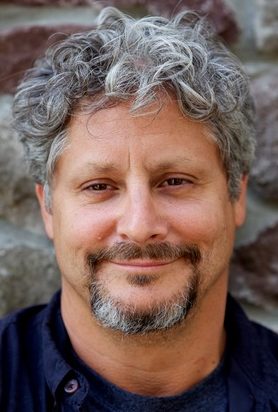By Victor Greto
NEWELL BEACH, AUSTRALIA — At first, I wasn’t sure how the beaches here could have remained so pristine.
Throughout the tropical northeastern arc of the Australian continent, smooth golden sands face a turquoise-blue Coral Sea. The fragmented but enormous Great Barrier Reef stretches along and well beyond the shoreline.
Standing on the shore, it feels as though you and only a small handful of people discovered this place and, against the odds, word had never gotten out.
But the real reason came to me after my first day spent at a friendly caravan park in Newell Beach, a place I reached after a 70-kilometer (43-mile) gorgeous coastal left-side-of-the-road drive up north from the airport in Cairns, the state of Queensland’s largest city, 1,600 miles north of Sydney.
It began with just a nudge at my leg.
I was in the ocean up to my chest, “prawning” with my brother Saverio.
Then, the pole I was holding also hit a bump; it was attached to a black mesh net and another pole at the opposite end that my brother held and which we were using to trawl for prawns — large shrimp.
“Let’s go in,” I said to him. “This is weird.”
We pulled at the opposite poles of the net with the weight of our bodies.
We had tied the poles to our waists, following the instructions of Lyle and Gloria, two Aussies vacationing at the caravan park who suggested we go prawning and who provided the net. We walked backwards out of the water to the shore.
Along with a dozen or so prawns, several (poisonous) puffer fish, ribbon fish and blue salmon, squirmed two meter-long hammerhead sharks and one floppily annoyed stingray.
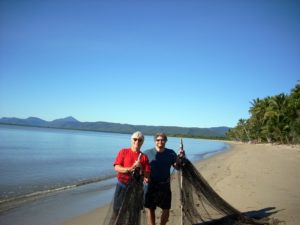 Ah. Yes.
Ah. Yes.
Gloria picked up the stingray by the tail. It flailed.
“Just put sand on your hand and you can hold it,” she suggested.
It was the same kind of fish that killed famous Australian Steve Irwin, the crocodile hunter, piercing his heart with the same kind of tail that Gloria held.
I said no, even while another newly-made Aussie friend from the park, Amanda, said she’d snap a digital image while I did so.
As for the sharks, one proved even tougher for Gloria to hold. A passerby volunteered to hold it. It squirmed in his hands like a writhing muscle.
“Want to hold it?” Gloria asked.
Crikey!
****
During the height of June and early July, it’s winter in Australia, and relatively safe to go into the ocean.
Come here to the oldest tropical rain forest in the world — Daintree rain forest, 1,200 square kilometers big with the largest range of plants and animals in the world, and only a handful of miles north of Newell Beach.
But be careful. Don’t go alone.
Even during the Australian winter there are crocodiles in the rivers and Amethyst Pythons hanging longingly from the trees just waiting for a Yank to walk unsuspectingly by.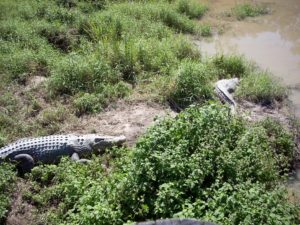
I saw a Mama Crocodile sunning its leathery armored skin while we tourists cruised along on a boat. We also saw two baby crocs.
And don’t go into the Coral Sea during the height of summer — say, in February, when it’s unbearably hot, like Philadelphia in August.
On the pristine beach where my brother and I leisurely trawled, the owner who runs the caravan park where we stayed told us that during the summer there are crocodiles that traverse one portion of the beach to the other. There are more sharks, of course, and stingrays.
But worst of all are the “stingers,” or poisonous box jellyfish that gather round you like moths to a flame and sting you to death.
“Nobody goes into the water during the summer,” Joy, the owner, told me.
She told me there there was no chance to survive the sting, and that the pain was so severe I would drown from the shock.
Well, that explained it — the pristine beaches, I mean.
Welcome to Australia.
****
I went to Australia because my 54-year-old brother was reliving a piece of his youth. He had honeymooned there 26 years earlier, and even stayed in the same room he and his wife had stayed.
I volunteered to check it out with him, figuring I’d probably never go to Australia ever again. (This was before I knew about the sharks and stingrays and crocodiles and stingers. Did I tell you about the snakes and rats — all bigger than our own — that linger and wrestle each other in the sugarcane fields that fill the landscape? As portions of the fields are harvested, you can see huge vultures swirling in the air above them contemplating dinner.)
For me, being in Australia was different than any trip I had taken.
The plane ride itself from Philadelphia to Los Angeles to Sydney to Cairns (without the layovers) is nearly 24 hours.
The ticket cost me about $1,700.
When I tried at first to buy tickets to fly on weekend days, I found that it would have cost me almost twice as much. I got the “deal” through Expedia.com, by leaving and returning on weekdays. I also had to get a travel visa, for all of $15.
Unless you have big bucks, you’ll be stuck in economy seats, so you need to get up and stretch every hour or so during the 14-hour flight from Los Angeles to Sydney.
For me, the jet lag wasn’t so bad. When I got there, I felt sleepy by 9 p.m. the first couple of nights (Australian time is 14 hours ahead of the east coast United States, and when you go there you cross the international dateline). When I got back, I slept dreamlessly hard the first night, but then I was fine.
Australia is as big as the continental United States, but holds only a bit more than 20 million people, most of whom are descendants of the English, Irish or Scots. Just about all live along the perimeter of the continent.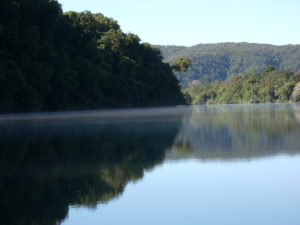
As everyone seems to know, Australia started as a prison colony, and many of the people who live there now are their descendants.
Their thick, often high-pitched accents are charming. They also speak unique phrases such as, “Good on ya!” — which expresses approval; being asked “to tea,” is actually being asked to eat a meal.
There’s a minority of aborigines who, like America’s Native American population, once had been nearly wiped out, but recently has been coming back.
There is a great deal of prejudice against them. In fact, after talking to and overhearing some white Aussies speak, their prejudice reminded me of the bold, old-style American white prejudice against African Americans.
One Aussie, noting my darker Italian color, said many of her compatriots call us darker types “wogs.”
I didn’t ask why, but found out later the word began during the British colonial period. It was first used to label the darker-skinned natives they encountered and often conquered.
But mostly they called my brother and I “Yanks,” and, more often than not, “mad Yanks,” because we both acted silly and drank a lot.
But we were good mad Yanks, my brother’s friend Jeff told me.
“Most of you Americans are loud and arrogant,” he said.
“My brother’s loud and arrogant,” I offered.
“He’s loud but he’s very….,” he said.
“Sociable?” I offered again.
And that helped make all the difference for a great experience.
By the time I got there, my brother already had lived there for a month and made friends with more than a dozen of the tenants of the caravan park, including one couple, Frank and Jan.
Jan introduced herself to me as a Persian terrorist (even though she’s from Saudi Arabia and has lived in Australia for decades) because one of the current entrenched American stereotypes includes the unfortunate idea that we live in stark fear of Arabs and Muslims, and treat them accordingly.
****
If I felt “manly” there at times, it was in spite of myself.
Usually, my idea of a good time is either looking at very old paintings and sculptures in museums, walking around and smoking a cigar, or slow-dancing with a woman.
But prawning? Until the shark nudged me, that was fine. My brother and I also spent time collecting coconuts by the shore. We walked miles to the nearest small town, Mossman (population 2,000), where we noted many fields of sugarcane (with the accompanying rustle of the nasty vermin within).
We walked a 2-kilometer trail in the Mossman Gorge, located at the southern tip of Daintree National Park, a rain forest filled with gorgeous examples of strangling figs, a plethora of trees with hollowed, surface roots. We also noted the tracks of wild pigs. (Did I tell you about the wild pigs yet? An Englishman brought some domestic pigs with him to Australia, where they, well, went wild. They often only come out at night.)
We drove to a tourist town called Kuranda, nestled in the “The Great Dividing Range,” which gives Queensland its distinctive beauty. In fact, the mountain range and the ancient rainforests make the trip here more than worth the money and the travel time, despite the impossibility of beaching. Tropical but pavement-rich and monotonously flat South Florida has nothing on this place.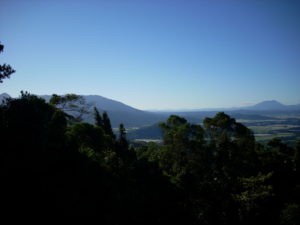
Kuranda and its popular coastal neighbor Port Douglas are tourist paradises (or traps) because they are filled with trendy restaurants, souvenir shops and Internet cafes. Aussies love to hate these places.
When our caravan park friends Jeff and Amanda went there, Jeff told me that he would have preferred some form of torture than hanging around while Amanda gloried from shop to shop and tried on clothes.
****
Then, there is snorkeling on the Great Barrier Reef.
One early morning, my brother, myself and Jeff and Amanda boarded “Poseidon,” a boat that takes tourists from Port Douglas, just south of Newell Beach, out to a series of three reefs called the Agincourt Ribbon reefs.
We sailed for nearly 90 minutes to get to the Reef. It cost about $150 to snorkel, $200 to scuba dive. I did the former, my brother did the latter.
Jeff went with my brother to dive, while I went with Amanda to snorkel.
The ocean got more impossibly bluer the further we went out. You can’t miss the reef. From the surface, it looks like a series of large patches of green, and extends — with irregular breaks — as far as the eye can see.
The first time I went out, with Amanda, I swallowed seawater and got the boat folks to bring me in.
A pathetic sissified Yank, I sat out the next snorkel because I didn’t want to swallow seawater again, and despaired of seeing the wildlife swimming below me. I wasn’t sure what my problem was, because I had snorkeled once before in Key West and did just fine.
But during my final chance, my brother said he’d go with me.
Hearing my labored breathing through the tube, I stayed near the ship while I got comfortable sticking my face in the water and breathing. My brother made sure my mask was on tight.
I went out. And I was rewarded.
For an hour, I saw brilliantly-colored schools of fish — bright red, deep blue, lime green — huge, open-mouthed clams, and the twisting, spiky coral itself, sometimes just inches below my body. I twisted and turned to miss it (“It’s razor-sharp,” the boat folks had warned). Life swarmed all around me.
Then it happened: Perhaps only 12 feet below me, a six-foot-long black-tipped shark swam.
Silently, of course. I could hear nothing but my own breathing. I couldn’t even feel my own body since it was floating.
And I think that combination of feelings gave me the one great epiphany I realized in Australia.
A shark looks as menacing in real life as it does on TV or in the movies. But, when you’re floating just above it and you only can hear your own breathing, the entire world becomes something different.
I was overcome by curiosity, stunned by the colorful beauty around myself, but uncaringly aware of the menacing silence.
Floating above the Great Barrier Reef, I was ready to be eaten, as well as ready to observe.
Then we kicked our way back toward the boat.
